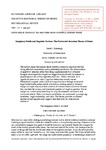Imaginary relish and exquisite torture: The elaborated intrusion theory of desire
| dc.contributor.author | Kavanagh, DJ | |
| dc.contributor.author | Andrade, Jackie | |
| dc.contributor.author | May, Jon | |
| dc.date.accessioned | 2012-05-18T12:20:24Z | |
| dc.date.available | 2012-05-18T12:20:24Z | |
| dc.date.issued | 2005-04 | |
| dc.identifier.issn | 0033-295X | |
| dc.identifier.issn | 1939-1471 | |
| dc.identifier.uri | http://hdl.handle.net/10026.1/988 | |
| dc.description.abstract |
The authors argue that human desire involves conscious cognition that has strong affective connotation and is potentially involved in the determination of appetitive behavior rather than being epiphenomenal to it. Intrusive thoughts about appetitive targets are triggered automatically by external or physiological cues and by cognitive associates. When intrusions elicit significant pleasure or relief, cognitive elaboration usually ensues. Elaboration competes with concurrent cognitive tasks through retrieval of target-related information and its retention in working memory. Sensory images are especially important products of intrusion and elaboration because they simulate the sensory and emotional qualities of target acquisition. Desire images are momentarily rewarding but amplify awareness of somatic and emotional deficits. Effects of desires on behavior are moderated by competing incentives, target availability, and skills. The theory provides a coherent account of existing data and suggests new directions for research and treatment. | |
| dc.format.extent | 446-467 | |
| dc.format.medium | ||
| dc.language | EN | |
| dc.language.iso | EN | |
| dc.publisher | AMER PSYCHOLOGICAL ASSOC | |
| dc.subject | OBSESSIVE-COMPULSIVE DISORDER | |
| dc.subject | ALCOHOL CUE REACTIVITY | |
| dc.subject | VISUAL-MENTAL-IMAGERY | |
| dc.subject | DRUG-USE BEHAVIOR | |
| dc.subject | THOUGHT SUPPRESSION | |
| dc.subject | SMOKING URGES | |
| dc.subject | WORKING-MEMORY | |
| dc.subject | SELF-EFFICACY | |
| dc.subject | EYE-MOVEMENTS | |
| dc.subject | INDIVIDUAL-DIFFERENCES | |
| dc.title | Imaginary relish and exquisite torture: The elaborated intrusion theory of desire | |
| dc.type | journal-article | |
| dc.type | Article | |
| plymouth.author-url | https://www.webofscience.com/api/gateway?GWVersion=2&SrcApp=PARTNER_APP&SrcAuth=LinksAMR&KeyUT=WOS:000227887600006&DestLinkType=FullRecord&DestApp=ALL_WOS&UsrCustomerID=11bb513d99f797142bcfeffcc58ea008 | |
| plymouth.issue | 2 | |
| plymouth.volume | 112 | |
| plymouth.publication-status | Published online | |
| plymouth.journal | PSYCHOL REV | |
| dc.identifier.doi | 10.1037/0033-295X.112.2.446 | |
| plymouth.organisational-group | /Plymouth | |
| plymouth.organisational-group | /Plymouth/Admin Group - REF | |
| plymouth.organisational-group | /Plymouth/Admin Group - REF/REF Admin Group - FoH | |
| plymouth.organisational-group | /Plymouth/Faculty of Health | |
| plymouth.organisational-group | /Plymouth/Faculty of Health/School of Psychology | |
| plymouth.organisational-group | /Plymouth/REF 2021 Researchers by UoA | |
| plymouth.organisational-group | /Plymouth/REF 2021 Researchers by UoA/UoA04 Psychology, Psychiatry and Neuroscience | |
| plymouth.organisational-group | /Plymouth/REF 2021 Researchers by UoA/UoA04 Psychology, Psychiatry and Neuroscience/UoA04 REF peer reviewers | |
| plymouth.organisational-group | /Plymouth/Research Groups | |
| plymouth.organisational-group | /Plymouth/Research Groups/Centre for Brain, Cognition and Behaviour (CBCB) | |
| plymouth.organisational-group | /Plymouth/Research Groups/Centre for Brain, Cognition and Behaviour (CBCB)/Behaviour | |
| plymouth.organisational-group | /Plymouth/Research Groups/Centre for Brain, Cognition and Behaviour (CBCB)/Cognition | |
| plymouth.organisational-group | /Plymouth/Research Groups/Institute of Health and Community | |
| plymouth.organisational-group | /Plymouth/Research Groups/Plymouth Institute of Health and Care Research (PIHR) | |
| plymouth.organisational-group | /Plymouth/Users by role | |
| plymouth.organisational-group | /Plymouth/Users by role/Academics | |
| dc.publisher.place | United States | |
| dc.identifier.eissn | 1939-1471 | |
| dc.rights.embargoperiod | Not known | |
| rioxxterms.versionofrecord | 10.1037/0033-295X.112.2.446 | |
| rioxxterms.licenseref.uri | http://www.rioxx.net/licenses/all-rights-reserved | |
| rioxxterms.type | Journal Article/Review |


